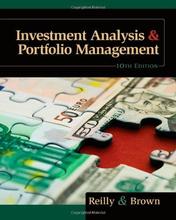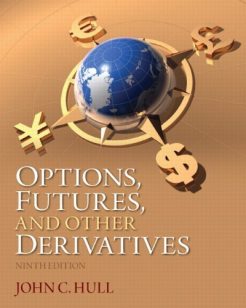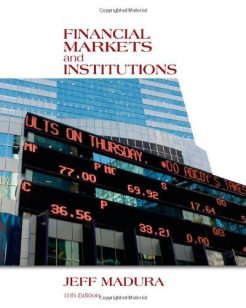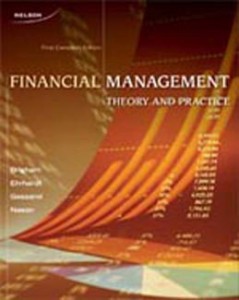Description
Investment Analysis and Portfolio Management
Investment Analysis and Portfolio Management Reilly Brown
Investment Analysis and Portfolio Management Reilly Brown 10th
Investment Analysis and Portfolio Management Reilly Brown 10th Test Bank
Investment Analysis and Portfolio Management Reilly 10th Edition Test Bank
***THIS IS NOT THE ACTUAL BOOK. YOU ARE BUYING the Test Bank in e-version of the following book***
Name: Investment Analysis and Portfolio Management
Author: Reilly Brown
Edition: 10th
ISBN-10: 0538482389
Type: Test Bank
– The test bank is what most professors use an a reference when making exams for their students, which means there’s a very high chance that you will see a very similar, if not exact the exact, question in the test!
– The file is either in pdf, doc, rtf or zipped in the package and can easily be read on PCs and Macs.
– Delivery is INSTANT. You can download the files IMMEDIATELY once payment is done.
If you have any questions, please feel free to contact us. Our response is the fastest. All questions will always be answered in 6 hours., most of the time within 30mins
We also faced similar difficulities when we were students, and we understand how you feel.
But now, with the Investment Analysis and Portfolio Management 10th Test Bank, you will be able to
* Anticipate the type of the questions that will appear in your exam.
* Reduces the hassle and stress of your student life.
* Improve your studying and also get a better grade!
* Get prepared for examination questions.
* Can save you time and help you understand the material.
This is the quality of service we are providing and we hope to be your helper.
Delivery is in the next moment. Test Bank is accurate.
Prepare to receive your Investment Analysis and Portfolio Management 10th Test Bank in the next moment.
ISBN-10: 0538482389
If you have any questions, or would like a receive a sample chapter before your purchase, please contact us at inquiry@testbankcorp.com
Investment Analysis and Portfolio Management
Investment Analysis and Portfolio Management Reilly Brown
Investment Analysis and Portfolio Management Reilly Brown 10th
Investment Analysis and Portfolio Management Reilly Brown 10th Test Bank
Investment Analysis and Portfolio Management Reilly 10th Edition Test Bank
CHAPTER 2—THE ASSET ALLOCATION DECISION
TRUE/FALSE
1. Experts suggest life insurance coverage should be seven to ten times an individual’s annual salary.
ANS: T PTS: 1
2. Term life insurance provides both a death benefit and a savings plan.
ANS: F PTS: 1
3. Most experts recommend a cash reserve of at least one year’s worth of living expenses.
ANS: F PTS: 1
4. The spending phase occurs when investors are relatively young.
ANS: F PTS: 1
5. The gifting phase is similar to, and may be concurrent with, the spending phase.
ANS: T PTS: 1
6. Long-term, high-priority goals include some form of financial independence.
ANS: T PTS: 1
7. It is not a good idea to get too specific when constructing your policy statement.
ANS: F PTS: 1
8. Asset allocation is the process of dividing funds into different classes of assets.
ANS: T PTS: 1
9. The typical investor’s goals rarely change during his/her lifetime.
ANS: F PTS: 1
10. Individual security selection is far more important than the asset allocation decision.
ANS: F PTS: 1
11. Return is the only important consideration when establishing investment objectives.
ANS: F PTS: 1
12. In constructing the portfolio, the manager should maximize the investor’s risk level.
ANS: F PTS: 1
13. Risk tolerance is exclusively a function of an individual’s psychological makeup.
ANS: F PTS: 1
14. An appropriate investment objective for a typical 25-year-old investor is a low-risk strategy, such as capital preservation or current income.
ANS: F PTS: 1
15. Investment planning is complicated by the tax code.
ANS: T PTS: 1
16. Average tax rate is defined as total tax payment divided by total income.
ANS: T PTS: 1
17. The portfolio mixes of institutional investors around the world are approximately the same.
ANS: F PTS: 1
18. The ability to retire at a certain age is a typical example of a long-term, lower-priority goal.
ANS: F PTS: 1
19. It is essential that both the client and the portfolio manager agree on an appropriate benchmark portfolio.
ANS: T PTS: 1
20. An example of a unique need in an investment policy statement is related to the legal responsibilities of a fiduciary or trustee.
ANS: F PTS: 1
21. Equity allocations of pension funds in Japan and Germany are similar to those in the United States.
ANS: F PTS: 1
22. Investing 30 to 40 percent of your retirement funds in the company you work for is reasonable when they match funds.
ANS: F PTS: 1
23. The majority of a pension fund’s return is explained by asset allocation.
ANS: T PTS: 1
MULTIPLE CHOICE
1. The current outlay of money to guard against a potentially large future loss is commonly known as
a. Asset management.
b. Portfolio management.
c. Minimizing risk.
d. Loss control.
e. Insurance.
ANS: E PTS: 1 OBJ: Multiple Choice
2. In an investment policy statement the objectives of an investor are expressed in terms of
a. risk and return
b. risk
c. return
d. time horizon
e. liquidity needs
ANS: A PTS: 1 OBJ: Multiple Choice
3. ____ phase is the stage when investors in their early-to-middle earning years attempt to accumulate assets to satisfy near-term needs, e.g., children’s education or down payment on a home.
a. Accumulation
b. Spending
c. Gifting
d. Consolidation
e. Divestiture
ANS: A PTS: 1 OBJ: Multiple Choice
4. Which of the following is not a life cycle phase?
a. Discovery phase
b. Accumulation phase
c. Consolidation phase
d. Spending phase
e. Gifting phase
ANS: A PTS: 1 OBJ: Multiple Choice
5. Which of the following is not a step in the portfolio management process?
a. Develop a policy statement.
b. Study current financial and economic conditions.
c. Construct the portfolio.
d. Monitor investor’s needs and market conditions.
e. Sell all assets and reinvestment proceeds at least once a year.
ANS: E PTS: 1 OBJ: Multiple Choice
6. The first step in the investment process is the development of a(n)
a. Objective statement.
b. Policy statement.
c. Financial statement.
d. Statement of cash needs.
e. Statement of cash flows.
ANS: B PTS: 1 OBJ: Multiple Choice
7. Which of the following is not considered to be an investment objective?
a. Capital preservation
b. Capital appreciation
c. Current income
d. Total return
e. None of the above (that is, all are considered investment objectives)
ANS: E PTS: 1 OBJ: Multiple Choice
8. ____ must be stated in terms of expected returns and risk. An investor’s tolerance for risk must be established before returns objectives can be stated.
a. Investment requirements
b. Investment constraints
c. Investment rewards
d. Investment objectives
e. Investment policy
ANS: D PTS: 1 OBJ: Multiple Choice
9. ____ is an appropriate objective for investors who want their portfolio to grow in real terms, i.e., exceed the rate of inflation.
a. Capital preservation
b. Capital appreciation
c. Portfolio growth
d. Value additivity
e. Nominal preservation
ANS: B PTS: 1 OBJ: Multiple Choice
10. ____ refer(s) to the ability to convert assets to cash quickly and at a fair market price and often increase(s) as one approaches the later stages of the investment life cycle.
a. Liquidity needs
b. Time horizons
c. Liquidation values
d. Liquidation essentials
e. Capital liquidations
ANS: A PTS: 1 OBJ: Multiple Choice
11. The policy statement may include a ____ against which a portfolio’s or portfolio manager’s performance can be measured.
a. Milestone
b. Benchmark
c. Landmark
d. Reference point
e. Market pair
ANS: B PTS: 1 OBJ: Multiple Choice
12. Asset allocation is
a. The process of dividing funds into asset classes.
b. Concerned with returns variability.
c. Concerned with the risk associated with different assets.
d. Concerned with the relationship among investments’ returns.
e. All of the above.
ANS: E PTS: 1 OBJ: Multiple Choice
13. The asset allocation decision must involve a consideration of
a. Cultural differences.
b. The objectives stated in the investor’s policy statement.
c. The types of assets that are appropriate for the investor.
d. The risk associated with different investments.
e. All of the above.
ANS: E PTS: 1 OBJ: Multiple Choice
14. Research has shown that the asset allocation decision explains ____% of the variation in fund returns across all funds, and ____% of the variation in returns for a particular fund over time.
a. 90 and 100.
b. 100 and 40.
c. 90 and 40.
d. 40 and 100.
e. 40 and 90.
ANS: E PTS: 1 OBJ: Multiple Choice
15. Once the portfolio is constructed, it must be continuously
a. Rebalanced.
b. Recycled
c. Reinvested
d. Monitored.
e. Manipulated.
ANS: D PTS: 1 OBJ: Multiple Choice
16. Which of the following statements is false?
a. Unrealized capital gains are taxable.
b. Realized capital gains are taxable.
c. Tax-exempt investments are attractive to individuals with high tax liabilities.
d. Returns comparisons should be made on an equivalent tax basis.
e. Tax exempt investors prefer tax exempt investments.
ANS: A PTS: 1 OBJ: Multiple Choice
17. ____ gains are taxable and occur when an asset is sold for more than its basis (the value of the asset when it was purchased by the original owner, or inherited by the heirs of the original owner).
a. Realized capital
b. Income
c. Portfolio
d. Nominal
e. Real
ANS: A PTS: 1 OBJ: Multiple Choice
18. Which of the following statements is true?
a. Except for tax-exempt investors and tax-deferred accounts, annual tax payments increase investment returns.
b. The only way to maintain purchasing power over time is to invest in bonds.
c. After adjusting for taxes, long-term bonds consistently outperform stocks.
d. An asset allocation decision for a taxable portfolio that does not include a substantial commitment to common stocks may make it difficult for the portfolio to maintain real value over time.
e. None of the above
ANS: D PTS: 1 OBJ: Multiple Choice
19. Important reasons for constructing a policy statement include:
a. Helps investors decide on realistic investment goals
b. Create a standard by which to judge the performance of the portfolio manager
c. Develop an instrument to judge risk
d. Choices a and b
e. All of the above
ANS: D PTS: 1 OBJ: Multiple Choice
20. For an investor with a time horizon of 6 to 10 years and lower risk tolerance, an appropriate asset allocation strategy would be
a. 100% stocks
b. 100% cash
c. 30% cash, 50% bonds, and 20% stocks
d. 10% cash, 30% bonds, and 60% stocks
e. 100% bonds
ANS: C PTS: 1 OBJ: Multiple Choice
21. For an investor with a time horizon of 8 years and higher risk tolerance, an appropriate asset allocation strategy would be
a. 100% stocks
b. 100% cash
c. 30% cash, 50% bonds, and 20% stocks
d. 10% cash, 30% bonds, and 60% stocks
e. 100% bonds
ANS: D PTS: 1 OBJ: Multiple Choice
22. For an investor with a time horizon of 12 years and higher risk tolerance, an appropriate asset allocation strategy would be
a. 100% stocks
b. 30% cash, 50% bonds, and 20% stocks
c. 10% cash, 30% bonds, and 60% stocks
d. 50% bonds and 50% stocks
e. 100% bonds
ANS: A PTS: 1 OBJ: Multiple Choice
23. For an investor with a time horizon of 15 years and moderate risk tolerance, an appropriate asset allocation strategy would be
a. 100% stocks
b. 40% cash and 60% stocks
c. 30% cash, 50% bonds, and 20% stocks
d. 50% bonds, and 50% stocks
e. 20% bonds, and 80% stocks
ANS: E PTS: 1 OBJ: Multiple Choice
24. For an investor with a time horizon of 4 years and higher risk tolerance, an appropriate asset allocation strategy would be
a. 100% cash
b. 30% cash, 50% bonds, and 20% stocks
c. 20% cash, 40% bonds, and 40% stocks
d. 10% cash, 40% bonds, and 50% stocks
e. 100% bonds
ANS: C PTS: 1 OBJ: Multiple Choice
25. For an investor with a time horizon of 5 years and moderate risk tolerance, an appropriate asset allocation strategy would be
a. 100% cash
b. 30% cash, 50% bonds, and 20% stocks
c. 20% cash, 40% bonds, and 40% stocks
d. 10% cash, 30% bonds, and 60% stocks
e. 100% bonds
ANS: B PTS: 1 OBJ: Multiple Choice
26. John is 55 years old has $55,000 outstanding on a mortgage and no other debt. John typically saves $5,000 in an IRA account and another $10,000 in a company pension. John is most likely in the:
a. Discovery phase
b. Accumulation phase
c. Consolidation phase
d. Spending phase
e. Gifting phase
ANS: C PTS: 1 OBJ: Multiple Choice
27. Which of the following is not a typical portfolio constraint?
a. Liquidity needs
b. Risk tolerance
c. Time horizon
d. Tax concerns
e. Legal factors
ANS: B PTS: 1 OBJ: Multiple Choice
28. Which of the following strategies seeks to increase the portfolio value by reinvesting current income in addition to capital gains?
a. Capital appreciation
b. Capital preservation
c. Return preservation
d. Current income
e. Total return
ANS: D PTS: 1 OBJ: Multiple Choice
29. Research from the 1970s to the 1990s found that over 90 percent of a fund’s returns over time is explained by:
a. Market timing
b. Stock selection
c. Manager selection
d. Asset allocation
e. All of the above
ANS: D PTS: 1 OBJ: Multiple Choice
Exhibit 2.1
USE THE TAX TABLE PROVIDED BELOW FOR THE FOLLOWING PROBLEM(S)
If Taxable Income Then The Tax is
Is Over But Not Over This Amount Plus This % Of The Excess Over
Single $0 $7,150 0 10% 0
$7,150 $29,050 715 15% $7,150
$29,050 $70,350 $4,000 25% $29,050
$70,350 $146,750 $14,325 28% $70,350
$146,750 $319,100 $35,717 33% $146,750
$319,100 – $92,592.50 35% $319,100
Married $0 $14,300 0 10% 0
Filing $14,300 $58,100 1430 15% $14,300
Jointly $58,100 $117,250 $8,000 25% $58,100
$117,250 $178,650 $22,787.50 28% $117,250
$178,650 $319,100 $39,979.50 33% $178,650
$319,100 – $86,328 35% $319,100
30. Refer to Exhibit 2.1. What is the marginal tax rate for a single individual with taxable income of $85,000?
a. 15%
b. 25%
c. 28%
d. 33%
e. 35%
ANS: C
Marginal tax rate = 28%
PTS: 1 OBJ: Multiple Choice Problem
31. Refer to Exhibit 2.1. What is the tax liability for a single individual with taxable income of $85,000?
a. $23,800
b. $18,427
c. $24,958
d. $16,867
e. $19,650
ANS: B
$14,325 + 0.28($85,000 ? $70,350) = $18,427 (tax bill)
PTS: 1 OBJ: Multiple Choice Problem
32. Refer to Exhibit 2.1. What is the average tax for a single individual with taxable income of $85,000?
a. 13.57%
b. 15.68%
c. 21.68%
d. 25.74%
e. 29.55%
ANS: C
$18,427/$85,000 = 21.68% (average tax rate)
PTS: 1 OBJ: Multiple Choice Problem
33. Refer to Exhibit 2.1. What is the tax liability for a married couple filing jointly with taxable income of $125,000?
a. $23,800
b. $18,427
c. $24,958
d. $16,867
e. $19,650
ANS: C
$22,787.50 + 0.28($125,000 ? $117,250) = $24,958
PTS: 1 OBJ: Multiple Choice Problem
34. What would the equivalent taxable yield be on an investment that offers a 6 percent tax exempt yield? Assume a marginal tax rate of 28%.
a. 0.125%
b. 7.20%
c. 6.48%
d. 8.33%
e. 32.14%
ANS: D
Equivalent taxable yield = .06/(1 ? .28) = .06/.72 = 8.33%
PTS: 1 OBJ: Multiple Choice Problem
35. What would the after-tax yield be on an investment that offers a 6 percent fully taxable yield? Assume a marginal tax rate of 31%.
a. 2.79%
b. 6.48%
c. 4.14%
d. 7.20%
e. 12.50%
ANS: C
After-tax yield = Before-tax yield (1 ? Tax Rate) = 6%(1 ? .31) = 4.14%
PTS: 1 OBJ: Multiple Choice Problem
36. The future value of $50,000 invested today, at the end of 10 years assuming an interest rate of 7.5% per year, with semiannual compounding, is
a. $104,407.60
b. $103,051.58
c. $123,510.52
d. $210,673.43
e. $105,117.46
ANS: A
FV = 50,000(1 + .0375)20 = $104,407.60
PTS: 1 OBJ: Multiple Choice Problem
37. Assume that you invest $750 at the end of each quarter for the next 20 years in a mutual fund. The annual rate of interest that you expect to earn in this account is 5.25%. The amount in the account at the end of 20 years is







Reviews
There are no reviews yet.